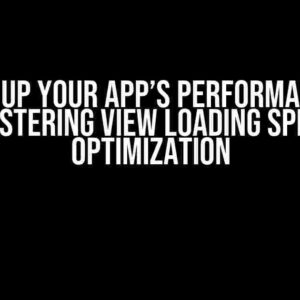As a mobile app developer, have you ever encountered a situation where you need to send custom headers in a POST request in Android using webview_flutter? Perhaps you’re working on an app that requires authentication tokens or API keys to access specific features. Whatever the reason, sending custom headers can be a game-changer for your app’s functionality and security. In this comprehensive guide, we’ll take you through the process of sending custom headers in a POST request in Android using webview_flutter.
What are Custom Headers and Why Do We Need Them?
Before we dive into the technicalities, let’s understand what custom headers are and why they’re essential in certain situations.
Custom headers are key-value pairs that can be added to HTTP requests to provide additional information about the request. They can be used to authenticate requests, provide metadata, or even control caching. In the context of Android app development using webview_flutter, custom headers can be used to:
- Authenticate requests using API keys or access tokens
- Specify the content type of the request body
- Provide additional metadata about the request
- Control caching and caching expiration
Preparing Your Android App for Custom Headers
Before you can send custom headers in a POST request, you need to set up your Android app to work with webview_flutter. Here are the steps to follow:
- Add the webview_flutter package to your pubspec.yaml file:
- Import the webview_flutter package in your Dart file:
- Create a new Flutter project or open an existing one:
- Replace the default MaterialApp with a Scaffold containing a WebView:
dependencies:
flutter:
sdk: flutter
webview_flutter: ^2.0.8
import 'package:webview_flutter/webview_flutter.dart';
flutter create my_app
Scaffold(
appBar: AppBar(
title: Text('Custom Headers in WebView Flutter'),
),
body: WebView(
initialUrl: 'https://example.com',
javascriptMode: JavascriptMode.unrestricted,
),
)
Sending Custom Headers in a POST Request
Now that your app is set up, let’s dive into the meat of the matter – sending custom headers in a POST request.
To send custom headers, you’ll need to use the `WebView` widget’s `postUrl` method, which takes three arguments:
- `url`: The URL of the request
- `headers`: A map of custom headers to be sent with the request
- `body`: The request body (optional)
Here’s an example of how to send a custom header using the `postUrl` method:
WebView(
initialUrl: 'https://example.com',
javascriptMode: JavascriptMode.unrestricted,
onWebViewCreated: (WebViewController controller) async {
final headers = {
'Authorization': 'Bearer YOUR_API_KEY',
'Content-Type': 'application/json',
};
final body = '{
"key": "value"
}';
await controller.postUrl('https://example.com/post', headers, body);
},
)In this example, we’re sending two custom headers – `Authorization` with a Bearer token and `Content-Type` with a value of `application/json`. We’re also sending a JSON request body.
Adding Multiple Custom Headers
If you need to add multiple custom headers, you can simply add more key-value pairs to the `headers` map:
final headers = {
'Authorization': 'Bearer YOUR_API_KEY',
'Content-Type': 'application/json',
'X-Custom-Header': 'custom-value',
'X-Another-Custom-Header': 'another-custom-value',
};In this example, we’re adding two additional custom headers – `X-Custom-Header` and `X-Another-Custom-Header`.
Common Use Cases for Custom Headers
Sending custom headers can be useful in a variety of scenarios. Here are some common use cases:
| Use Case | Description |
|---|---|
| Authentication | Sending API keys or access tokens to authenticate requests |
| Content Type | Sending the content type of the request body (e.g., application/json) |
| Metadata | Providing additional information about the request (e.g., user agent, device ID) |
| Caching | Controlling caching and caching expiration using headers like Cache-Control |
Conclusion
Sending custom headers in a POST request in Android using webview_flutter is a powerful technique that can unlock new possibilities for your app. By following the steps outlined in this guide, you can add custom headers to your HTTP requests and take your app’s functionality to the next level.
Remember to always handle errors and exceptions when working with custom headers, and be mindful of security best practices when transmitting sensitive information.
With this comprehensive guide, you’re now equipped to send custom headers like a pro and take your Android app development skills to new heights.
Happy coding!
Frequently Asked Question
Get ready to unlock the secrets of sending custom headers in a POST request in Android using webview_flutter!
Q1: Can I send custom headers in a POST request using webview_flutter?
Yes, you can! webview_flutter provides a way to send custom headers in a POST request using the `WebView.platformavigate` method. You can specify the headers as a `Map
Q2: How do I specify the custom headers in the WebView.platform.navigate method?
To specify custom headers, create a `Map
Q3: Can I set custom headers for all requests made by the WebView?
Unfortunately, no. The `WebView.platform.navigate` method only sets custom headers for the specific request being made. If you want to set custom headers for all requests made by the WebView, you’ll need to use a different approach, such as using a custom ` WebViewClient` and overriding the `shouldInterceptRequest` method.
Q4: How do I handle errors when sending custom headers in a POST request?
When sending custom headers in a POST request, you should always handle errors and exceptions that may occur. You can use try-catch blocks to catch any exceptions thrown by the `WebView.platform.navigate` method. Additionally, you can use the `WebView.onLoadError` callback to handle any errors that occur during the request.
Q5: Are there any security considerations when sending custom headers in a POST request?
Yes, there are! When sending custom headers in a POST request, make sure to handle sensitive information, such as authentication tokens or API keys, securely. Avoid hardcoding sensitive information in your code, and consider using secure storage options, such as the Android KeyStore, to store sensitive data.




